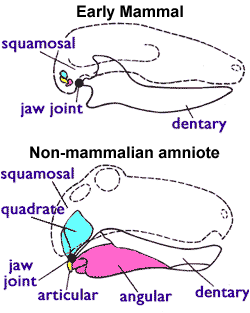 |
| A diagram showing the structural configuration of the jaw in reptiles and mammals. In the mammals the quadrate and articular bones have been reduced to the tiny bones of the middle ear. |
The ears of amphibians are primitive, a simple membrane of skin stretched over a nerve-window in the skull. Reptiles and diapsid reptiles converge on the same solution: the eardrum. The structure is similar in both groups of vertebrates.
Diapsid reptiles have jaws composed of multiple bones. The jaws of mammals are one solid piece of bone, the dentary. In the mammal embryo, additional bones the articular and quadrate of a diapsid reptile embryo, develop into the hammer and anvil bone of the middle ear.
In both lineages these bones connect at the primary jaw joint. To palaeontologists, the different configurations of the ear in diapsid reptiles and mammals suggested they converged on the solution independently. Now evidence to support this model has been illuminated not by fossils but by evolutionary development, the science of how embryological developments relates to evolutionary relationships.
Researchers from RIKEN Evolutionary Morphology Laboratory and the University of Tokyo in Japan noted that in mammals the eardrum was attached to the tympanic bone - a structure derived from the lower jaw - whilst in diapsids it was anchored to the quadrate - a bone in the upper jaw. The Ednra receptor is vital to the development of the jaw in embryos. The researchers studied the effects of removing the gene responsible for the receptor in mouse embryos. Specimens lacked eardrums and ear canals, showing that in mammals it is contingent on the correct development of the jaw.
Next they interfered with the Ednra receptor to block proper jaw development in chickens (birds are descended from diapsid reptiles). This resulted in duplicate eardrums and ear canals, with the additional set forming from upper jaw components developed within the malformed lower jaw. To understand how the eardrum evolved twice and why it is associated with different jaw components, the researchers looked at the expression of Bapxl, a protein involved with the formation of the primary jaw joint and its position relative to the future site of the eardrum. They found that in mouse embryos, Bapxl was expressed in cells just below the future site and in chickens considerably lower.
The result of this difference in the region of expression forces the eardrum to develop below the primary jaw joint in mammals, necessitating an association with the lower jaw, and above the joint in diapsids and their descendants. 'Convergent evolution can often result in structures that resemble each other so much that they appear to be homologous. But, developmental analyses can often reveal their different origins', said Chief Scientist Shigeru Kuratani.
The divergence in structure certainly originated with a genetic mutation. What advantage it conferred initially is harder to say, but this shift in middle ear evolution could help us understand other related evolutionary changes in mammals, including their ability to detect high pitched sounds and metabolic efficiency. In the predator-filled night of the Triassic Earth, sharp senses would have meant the difference between life and death.